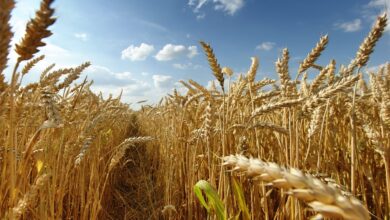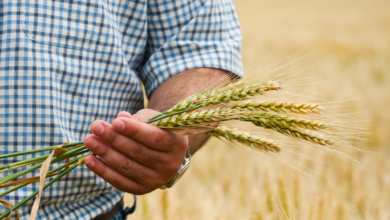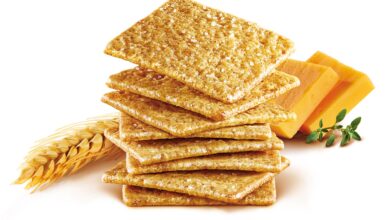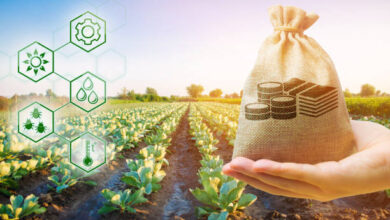
Modern day agriculture has seen a remarkable shift from traditional farming techniques to a more sophisticated and technology-driven approach. This shift is not only improving yields but also challenging the way we perceive farming and food production. In this blog post, we aim to delve into the intricacies of modern day agriculture, exploring its different aspects, from technology and genetic modification to organic farming and future prospects.
A Snapshot of Modern Day Agriculture
In the panorama of contemporary farming, modern day agriculture emerges as an intriguing blend of cutting-edge technology and commitment to sustainability. A far cry from traditional farming methods, it employs tech marvels such as GPS systems, automated machinery, and advanced data analytics. These tools allow farmers to keep a close eye on vital parameters such as crop growth and soil health, fostering a more informed, precise approach to agriculture.
With this shift, farmers have the power to boost their yield and minimize their environmental impact simultaneously. The cherry on top? Drones and remote sensing technology, making it easier for farmers to oversee large swaths of land with remarkable efficiency. This snapshot of modern agriculture is a testament to how far we’ve come in redefining farming and food production.
The Shift towards Technology-Driven Farming
As we dig deeper into the rich soil of modern agriculture, we unearth the trans formative impact of technology on farming. The landscape of farming has been dramatically reshaped with the infusion of technology, painting a picture quite different from the humble, plow-touting farmer of yesteryears. Farmers today are swapping their plows for high-tech gadgets and sophisticated software, giving birth to an era of technology-driven farming.
Imagine a world where monitoring weather patterns, analyzing soil health, and tracking crop growth are no longer arduous tasks but just a click away. That’s the power of technology in modern farming. Farmers today are harnessing the potential of sensors, drones, and GPS-guided machinery to bring real-time data at their fingertips. This data-driven approach is paving the way for precision farming, a revolutionary practice that applies resources such as water, fertilizer, and pesticides, exactly where and when they are needed. The result? A significant boost in crop yield and a drastic reduction in waste.
But the tale of technology in farming doesn’t end here. It also serves as a powerful ally in promoting sustainable farming practices. By enabling farmers to optimize the use of resources, technology not only increases productivity but also minimizes the environmental impact of farming. It’s like hitting two birds with one stone.
This leap into technology-driven farming, however, doesn’t come without its hurdles. The high costs of technology and the risk of data breaches pose significant challenges that need to be addressed as we continue to navigate this exciting journey of modern agriculture.
In a nutshell, the shift towards technology-driven farming is a game-changer. It’s reinventing the wheel of traditional farming, turning it into a smarter, more sustainable, and efficient practice. As we continue to embrace this digital revolution in agriculture, one thing is certain: farming will never be the same again.
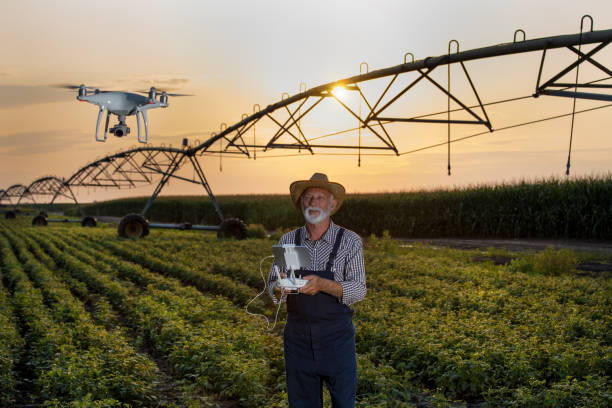
The Role of Genetic Modification in Agriculture
Venturing into the intriguing sphere of genetic modification reveals yet another facet of modern agriculture. This branch of biotechnology involves tweaking the genetic structure of crops, thereby magnifying specific desirable traits like resistance to diseases or the ability to thrive in harsh weather conditions. The advent of Genetically Modified Organisms (GMOs) has stirred quite a bit of debate, with critics raising concerns over potential health hazards. However, the undeniable truth remains – GMOs have a pivotal role in alleviating food scarcity, particularly in areas tormented by extreme climatic conditions.
Picture this – a drought-stricken area struggling to produce crops. Traditional farming methods would yield little to no harvest. However, the use of genetically modified crops that can withstand such adversities could mean the difference between starvation and survival. This is the potential power of genetic modification in modern day agriculture. But it’s not all rosy. The increasing reliance on GMOs has sparked a debate about potential health risks and ethical dilemmas. As we continue to tread the path of modern agriculture, navigating these concerns will be as crucial as reaping the benefits of this advanced science. It’s a complex story, this tale of genetic modification, but an integral chapter in the chronicles of modern day agriculture.
Organic Farming – A Counter Movement
In the world of agriculture, where technology and genetic engineering are driving forces, a contrasting trend is garnering attention – organic farming. This agricultural method bucks the trend of high-tech solutions and genetically modified crops. Instead, organic farming places its trust in nature’s own systems, employing methods such as crop rotation, composting, and biological pest control.
At its core, organic farming refuses the usage of synthetic fertilizers, pesticides, and genetically modified organisms, relying instead on a set of traditional farming practices and natural substances. These practices aim to enrich the soil’s fertility and maintain ecological balance, preserving the health of our planet while producing nutritious and chemical-free food.
The renaissance of organic farming can be attributed to a growing wave of consumer consciousness. An increasing number of people are becoming concerned about the food they consume, its impact on their health, and its footprint on the environment. This shift in consumer sentiment is reflected in the rising demand for organic produce, a trend that appears to be more than just a passing fad.
However, this green revolution in agriculture is not without its hurdles. Organic farming presents its unique set of challenges. The elimination of synthetic fertilizers and pesticides requires a more labor-intensive approach, escalating production costs. Additionally, organic yields tend to be lower than conventional farming, raising questions about its scalability and ability to feed a rapidly growing global population.
While organic farming embodies a commendable commitment to sustainability and health, its challenges cannot be overlooked. However, it is this very contrast – the hi-tech world of modern agriculture and the back-to-nature approach of organic farming – that makes the field of agriculture so fascinating. Each movement with its unique merits and challenges, both striving towards the common goal of a sustainable and food-secure future. It’s a remarkable narrative, this resurgence of organic farming, and a crucial element of the broader agriculture discourse.
The Benefits and Challenges of Modern Agriculture
The saga of modern agriculture is a tale of incredible gains, but it isn’t without its hurdles. On one hand, we have the remarkable perks that are turning the tides in favor of contemporary farming. The first and foremost is the incredible boost in productivity. With technology-guided farming and the use of GMOs, farmers are producing more food than ever before. And it’s not just about quantity; quality has seen a significant uptick too.
Then, there’s the push for sustainability. Modern farming practices, fueled by technology and data analytics, are drastically reducing waste and promoting efficient use of resources. For instance, precision farming is ensuring that every drop of water and every ounce of fertilizer counts. In turn, this is making agriculture more environmentally friendly, serving as a testament to how farming and sustainability can go hand in hand.
But, it’s not all sunshine and rainbows in the world of modern agriculture. There are challenges that are testing the mettle of farmers and agricultural scientists alike. The biggest one perhaps is the cost factor. Sophisticated machinery, advanced software, and high-end tech gadgets don’t come cheap. Not all farmers can afford these tools, leading to a divide in the agricultural community.
Next up is the cybersecurity risk. With farming becoming increasingly digital, the threat of data breaches looms large. Imagine, sensitive data about crop patterns, soil health, and farming strategies falling into the wrong hands. The consequences could be devastating.
Last but not least, we have the ongoing debate about GMOs. While they hold the potential to alleviate global food scarcity, concerns about their impact on health and biodiversity are valid and require careful consideration.
So, here we are, in the throes of a revolution in agriculture, reaping the rewards but also grappling with the challenges. As we navigate this uncharted territory, it will be interesting to see how we balance the scales between these remarkable gains and the looming hurdles. After all, the future of our food and our planet depends on it.
The Future of Modern Day Agriculture
What lies on the horizon for modern day agriculture? It’s a future fueled by innovation and a deep respect for our planet. The agricultural sector is primed for exciting developments that blend advanced technology, sustainable practices, and keen insights into consumer demands. We are witnessing a rise in innovative farming techniques such as vertical farming and aquaponics, designed to maximize space and conserve resources. Vertical farms stacked high with produce and fish swimming under crops might soon be a common sight, reflecting our adaptive spirit in the face of dwindling resources.
Biotechnology, despite its controversies, will continue its dance in the limelight, playing a critical role in enhancing crop characteristics for higher yield and disease resistance. This powerful tool, when used responsibly, can ensure that we don’t just have enough food to feed the world but also the right kind of food—nutritious and resilient.
Parallel to the march of technological progress, the resurgence of organic farming continues to gain momentum. As consumers become more aware and concerned about what goes into their bodies and how it impacts the environment, the demand for organic produce is unlikely to dwindle. This clearly signals room for both technologically-advanced and nature-driven farming methods in the market.
In a nutshell, the future of agriculture is a multifaceted gem, sparkling with the promise of technological advancements, the resilience of traditional methods, and a surge in organic trends. It’s a thrilling time to be part of this journey, as we strive to strike a balance between innovation and sustainability, productivity and health, technology and nature. While the challenges are real, the potential rewards are immense. This, in essence, is the promising and complex terrain of modern day agriculture’s future. It’s a future we build today, every time we sow a seed, turn on a drone, or choose a piece of organic fruit.
